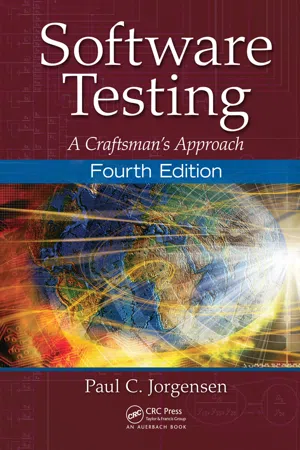
- 494 pages
- English
- ePUB (mobile friendly)
- Available on iOS & Android
About this book
This updated and reorganized fourth edition of Software Testing: A Craftsman's Approach applies the strong mathematics content of previous editions to a coherent treatment of Model-Based Testing for both code-based (structural) and specification-based (functional) testing. These techniques are extended from the usual unit testing discussions to full coverage of less understood levels integration and system testing.
The Fourth Edition:
- Emphasizes technical inspections and is supplemented by an appendix with a full package of documents required for a sample Use Case technical inspection
- Introduces an innovative approach that merges the Event-Driven Petri Nets from the earlier editions with the "Swim Lane" concept from the Unified Modeling Language (UML) that permits model-based testing for four levels of interaction among constituents in a System of Systems
- Introduces model-based development and provides an explanation of how to conduct testing within model-based development environments
- Presents a new section on methods for testing software in an Agile programming environment
- Explores test-driven development, reexamines all-pairs testing, and explains the four contexts of software testing
-
Thoroughly revised and updated, Software Testing: A Craftsman's Approach, Fourth Edition is sure to become a standard reference for those who need to stay up to date with evolving technologies in software testing. Carrying on the tradition of previous editions, it will continue to serve as a valuable reference for software testers, developers, and engineers.
Frequently asked questions
- Essential is ideal for learners and professionals who enjoy exploring a wide range of subjects. Access the Essential Library with 800,000+ trusted titles and best-sellers across business, personal growth, and the humanities. Includes unlimited reading time and Standard Read Aloud voice.
- Complete: Perfect for advanced learners and researchers needing full, unrestricted access. Unlock 1.4M+ books across hundreds of subjects, including academic and specialized titles. The Complete Plan also includes advanced features like Premium Read Aloud and Research Assistant.
Please note we cannot support devices running on iOS 13 and Android 7 or earlier. Learn more about using the app.
Information
I
A MATHEMATICAL
CONTEXT
Chapter 1
A Perspective on Testing
1.1 Basic Definitions

1.2 Test Cases
Table of contents
- Cover
- Half Title
- Title Page
- Copyright Page
- Dedication
- Table of Contents
- Preface to the Fourth Edition
- Preface to the Third Edition
- Preface to the Second Edition
- Preface to the First Edition
- Author
- Abstract
- Part I A Mathematical Context
- Part II Unit Testing
- Part III Beyond Unit Testing
- Appendix: Complete Technical Inspection Packet
- Index